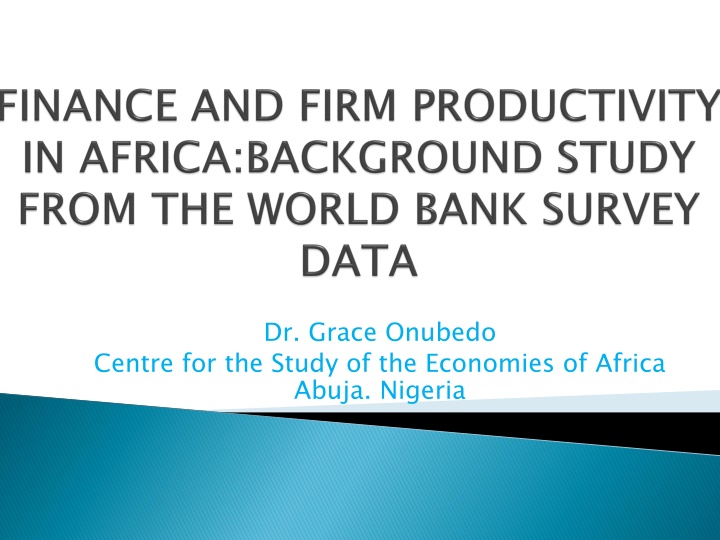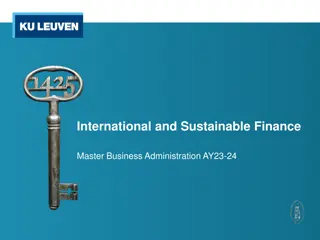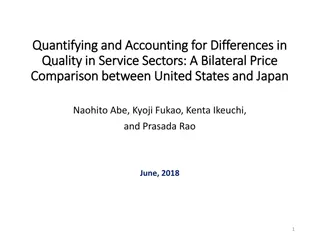Finance and Productivity in Africa: Implications and Solutions
Study conducted by Dr. Grace Onubedo at the Centre for the Study of the Economies of Africa in Abuja, Nigeria, focusing on the impact of access to finance on firms' productivity in Africa. The research addresses the financing gap faced by firms in developing countries and the under-developed financial systems in Africa, highlighting the importance of both internal and external finances for firms' growth and innovation. The study emphasizes the need for better access to finance to enhance productivity and economic development in the region.
Uploaded on Mar 03, 2025 | 1 Views
Download Presentation

Please find below an Image/Link to download the presentation.
The content on the website is provided AS IS for your information and personal use only. It may not be sold, licensed, or shared on other websites without obtaining consent from the author.If you encounter any issues during the download, it is possible that the publisher has removed the file from their server.
You are allowed to download the files provided on this website for personal or commercial use, subject to the condition that they are used lawfully. All files are the property of their respective owners.
The content on the website is provided AS IS for your information and personal use only. It may not be sold, licensed, or shared on other websites without obtaining consent from the author.
E N D
Presentation Transcript
Dr. Grace Onubedo Centre for the Study of the Economies of Africa Abuja. Nigeria
Introduction Background of the study Composition of finance Methodology and Analytical Framework Data and Variable Description Results and Policy Implication
Motivation for the study What s the problem? The financing-gap faced by firms in developing countries The under-developed nature of Africa s financial systems How does this research come in? Uses direct measures of access to finance to examine the linkage with firms productivity in Africa Measures firms productivity using the TFP model, labour productivity and stochastic frontier model
The effect of access to finance on firmsproductivity: External finances increases the number of start-ups Finance is required by existing firms to allow them benefit from investment and growth opportunities and be able to achieve bigger equilibrium size For the acquisition of assets portfolio that are more efficient and productive
The effect of access to finance on firmsproductivity: Internal finances helps to improve entry growth, reduces risk, promotes innovation, and increases equilibrium size Essential for the daily operations of the firm and the achievement of long-term investment opportunities. development goals and It also enhances the performance of the aggregate economy via stronger financial systems and facilitates investment in productivity-enhancing innovative firms. projects by
The unavailability of finance both internally and externally is a major business obstacle firms face because firms require more finance to achieve higher levels of productivity and growth Firms face further constraints as a result of differing pattern and extent of finance needed by different firms in various countries Economists and policy makers place particular interest on the unavailability of external finance resulting from imperfect financial market because they have important implications for monetary policy transmission mechanism and tax policy
Biggest Obstacles faced by firms in Sub-Saharan Africa (%) Approximately 25% of firms surveyed reported that access to finance was the biggest obstacle they face
Proportion of Investments Financed by Various Sources of Finance (%) 70% financed by internal funds 10% financed by banks 5% financed by supplier credit and equity
Percentage of firm using financing for working capital (%) 70% financed by internal funds 10% financed by banks 5% financed by supplier credit and equity
Percentage of firms using financing for Investment (%) 91% financed by internal funds 60% financed by banks 5%% financed by supplier credit and equity
Firms access to finance (%) 31% access to overdraft facilities 25% access to credit line/loan 87% access to checking/saving account
Access to finance based on type of ownership (%) Checking/Saving Account Checking/Saving Account Type Type of of Ownership Ownership Overdraft Overdraft Credit Credit Line/Loan Line/Loan YES NO YES NO YES NO Incorporations Incorporations With With Traded Traded Shares Shares 35% 65% 28% 72% 90% 10% Incorporations Shares Incorporations With Shares With Non Non- -Traded Traded 36% 64% 28% 72% 93% 7% Sole Sole Proprietorship Proprietorship 14% 86% 11% 89% 79% 21% Partnership Partnership 21% 79% 21% 79% 87% 13% Limited Limited Partnership Partnership 40% 60% 29% 71% 92% 8%
Model Estimation: o OLS estimates ?????= ??+ ?1???? + ?2 ????+ ?3???+ ?4???+ ??? ????? denote the firm and year respectively. Y is the dependent variable measured by estimates of labour productivity and total factor productivity. AC is the main explanatory variables (the three measures of access to internal and external finance). OB is also an explanatory variable capturing firms perceived effect of finance constraints. F is firm-level characteristics. C captures country characteristics and ? is the error term. 1
Model Estimation: o IV-GMM o From equation 1, potential econometric issues i.e. endogeneity might arise. Particularly, measures of access to credit are potentially endogenous because banks are more willing to provide finance to firms with higher levels of productivity o This study uses the type of ownership and the sex of the owner(s) as instruments for access to credit. o The type of ownership (i.e. sole-proprietorship, partnership, non-listed or listed companies) is likely to influence the ability of a firm to access credit (e.g. firms would willingly lend to listed companies with limited liabilities) (Kira and He, 2012). o Also, the gender of the owner(s) influences a firm s ability to access finance.
Model Estimation: o Stochastic Frontier The stochastic frontier model can be specified as: ??=?(???)+ ?? (2) Where Y denotes the maximum output obtainable from ??, a vector whose values are functions of inputs (non- stochastic inputs), ? is a vector of unknown parameters to be estimated, and ?? is the disturbance term.
The Cobb-Douglas functional form for the stochastic frontier is given as: ?????= ?0+ ?1 ???????+?2???? + ?3 ????+ ?4???+??? ??? (3) And the trans-logarithmic functional form for the stochastic frontier is given as: ?????= ?0+ ?1?????+12 ??,? ????????+?2???? + ?3 ????+ ?4???+??? ??? (4) Where Y represents the quantity of output produced, ?1 represents the total labour cost (including wages, salaries and bonuses), ?2 is the net book values of machinery vehicles, equipment, land and building or the cost of raw material and intermediate goods used
Estimating Productivity : Firms productivity is estimated using three measures: Labour productivity Total Factor Productivity Stochastic frontier Cobb-Douglas and translog model Labour Productivity: is equal to the total annual sales in the last fiscal year divided by the number of permanent, full-time employees in the firm at the end of last fiscal year
Estimating Productivity : Total Factor Productivity: Estimates of productivity can be gotten as the difference between actual output and output estimated by a production function using actual input quantities (Gatti and Love 2008). Productivity can be obtained from the regression of: ???? = ?+??????+ ??????+ ?? (5) Where ?? is firm s output, K and L are capital and labour, ?? and ?? are capital and labour shares and ?? is the error term. TFP, the estimated residual, is obtained in this model as the difference between actual and predicted output, or ?? =???? ???? .
Estimating Productivity : Total Factor Productivity : In this study: Labour is captured using the total labour cost (including wages, salaries and bonuses) Capital is captured using either the addition of net book values of machinery vehicles, equipment, land and building or the cost of raw material and intermediate goods used in production in the last fiscal year.
This study uses the World Bank Enterprise survey data. The Enterprise surveys (ES) are an ongoing project by the World Bank. 17 African Countries with data for at least two periods and build a pure cross-sectional data for the years ranging from 2006-2014. The total number of firms with data on all the required variables is 4682. Shows that about 66% of firms in our sample are small firms (5 to 19 employees), 26% are medium (20 to 99 employees) and only 8% are large firms (more than 100 employees). Also, approximately 79% and 83% of firms in our sample do not have overdraft facilities and loan respectively, while only 15% do not have checking/savings accounts.
Access to Finance: Overdraft - is a dummy variable equal to one if the firm has no overdraft facility at the time of the survey and zero otherwise Credit line/loan - is a dummy variable equal to one if the firm has no line of credit or loan from a financial institution at the time of the survey and zero otherwise Checking Account - is a dummy variable equal to one if the firm has no checking or savings account at the time of the survey and zero otherwise In this study, we assume that overdraft and credit line/loan capture firms access to external finance because they are short-term (overdraft) and long-term (credit line/loan) debt services provided by financial institutions. Checking/saving account is used to capture access to internal finance based on the assumption that firms would keep retained earnings in a current account with banks or in a savings account to earn some interest until when the funds are needed.
Firms Perception of Finance No obstacle is a dummy variable equal to one if finance is no obstacle to the firms operation at the time of the survey and zero otherwise Minor obstacle is a dummy variable equal to one if finance is a minor obstacle to the firms operation at the time of the survey and zero otherwise Moderate obstacle is a dummy variable equal to one if finance is a moderate obstacle to the firms operation at the time of the survey and zero otherwise Major obstacle is a dummy variable equal to one if finance is a major obstacle to the firms operation at the time of the survey and zero otherwise Very Severe obstacle is a dummy variable equal to one if finance is a very severe obstacle to the firms operation at the time of the survey and zero otherwise.
We control for firm-level characteristics that might affect a firms productivity and ability to access financial services. Particularly, dummy variables are constructed to capture firms size (small, medium and large), publicly listed firms, sole proprietorships, firms age (log values), and managerial experience (log values). To control for country-level characteristics data from World Bank is used for individual countries and years of survey to capture GDP per capita and domestic credit to the private sector by banks (% of GDP). GDP per capita measures economic growth while domestic credit is a measure of the level of financial development of the economy the firm is operating.
(1) (1) (2) (2) (3) (3) (4) (4) Dependent Variable: Total Factor Productivity: Labour Cost and Material Cost (Log Value) Overdraft (0.040) Credit Line/Loan (0.050) Checking Account (0.047) Moderate Obstacle Dependent Variable: Total Factor Productivity: Labour Cost and Material Cost (Log Value) Overdraft -0.196*** -0.188*** (0.043) -0.082* (0.045) -0.111 ** (0.048) 0.134*** (0.050) -0.001 (0.047) -0.138 *** (0.050) -0.147*** (0.043) -0.046 (0.045) -0.078 (0.048) 0.165 *** (0.050) 0.016 (0.046) -0.122 (0.049) -0.294*** (0.067) -0.280*** (0.066) 0.112*** (0.023) 0.021 (0.024) -0.257*** (0.043) - 0.047 (0.044) - 0.141*** (0.048) 0.069 (0.050) -0.082* (0.046) -0.236*** (0.049) -0.799*** (0.057) -0.432*** (0.056) 0.232*** (0.038) 0.005 (0.024) 0.445*** (0.024) 0.004*** (0.0004) 4682 -0.099** Credit Line/Loan -0.109** Checking Account Moderate Obstacle Major Obstacle Major Obstacle Very Severe Obstacle Very Severe Obstacle Small Firm Small Firm Medium Firm Medium Firm Age of Firm (Log) Age of Firm (Log) Managerial Experience (Log) Managerial Experience (Log) GDP Per Capita (Log) GDP Per Capita (Log) Domestic Credit Domestic Credit Observations Observations 4976 4746 4682
(1) (1) (2) (2) (3) (3) (4) (4) Dependent Variable: Total Factor Productivity: Labour Cost and Material Cost (Log Value) Overdraft Dependent Variable: Total Factor Productivity: Labour Cost and Material Cost (Log Value) Overdraft -0.337*** (0.043) -0.133*** (0.043) -0.230*** (0.052) -0.320*** (0.045) -0.112** (0.046)) -0.224*** (0.053) 0.023 (0.050) -0.128*** (0.047) -0.289*** (0.051) -0.131*** (0.045) -0.010 (0.045) -0.142*** (0.053) 0.082* (0.049) -0.054 (0.047) -0.189*** (0.050) -0.825*** (0.058) -0.448*** (0.056) 0.120*** (0.039) 0.006 (0.025) -0.144*** (0.045) 0.167*** (0.019) -0.135*** (0.052) 0.048 (0.049) -0.055 (0.046) -0.187*** (0.050) -0.790*** (0.057) -0.413*** (0.056) 0.168*** (0.040) -0.027 (0.025) 0.136 (0.108) 0.040*** (0.005) 4682 0.123 YES Credit Line/Loan Credit Line/Loan Checking Account Checking Account Moderate Obstacle Moderate Obstacle Major Obstacle Major Obstacle Very Severe Obstacle Very Severe Obstacle Small Firm Small Firm Medium Firm Medium Firm Age of Firm (Log) Age of Firm (Log) Managerial Experience (Log) Managerial Experience (Log) GDP Per Capita (Log) GDP Per Capita (Log) Domestic Credit Domestic Credit Observations R R- -Squared Country Dummy Observations Squared Country Dummy 5086 0.039 YES 4836 0.048 YES 4682 0.103 YES
Dependent Variable: TFP: No of Fulltime Employees and NBV of Machinery (Log Value) Variables Overdraft Variables Overdraft Coefficients -0.174*** (0.048) -0.079* (0.047) 0.032 (0.061) 0.018 (0.055) -0.063 (0.053) -0.222*** (0.057) -0.429*** (0.062) -0.179*** (0.060) -0.054 (0.045) -0.063 (0.053) 0.015 (0.029) 0.001** (0.001) 3401 0.038 Coefficients Credit Line/Loan Credit Line/Loan Checking Account Checking Account Moderate Obstacle Moderate Obstacle Major Obstacle Major Obstacle Very Severe Obstacle Very Severe Obstacle Small Firm Small Firm Medium Firm Medium Firm Age of Firm (Log) Age of Firm (Log) Managerial Experience (Log) Managerial Experience (Log) GDP Per Capita (Log) GDP Per Capita (Log) Domestic Credit Domestic Credit Observations R R- -Squared Observations Squared
Small Small Medium Medium Large Large Dependent Variable: Total Factor Productivity: Labour Cost and Material Cost (Log Value) Dependent Variable: Total Factor Productivity: Labour Cost and Material Cost (Log Value) -0.138* (0.075) -0.178*** (0.065) -0.168* (0.088) Overdraft Overdraft -0.129* (0.073) 0.054 (0.067) 0.080 (0.086) Credit Line/Loan Credit Line/Loan -0.071** (0.064) -0.096 (0.120) -0.307 (0.198) Checking Account Checking Account 0.146** (0.073) -0.084 (0.078) -0.032 (0.108) Moderate Obstacle Moderate Obstacle -0.034 (0.064) -0.070 (0.078) -0.068 (0.123) Major Obstacle Major Obstacle -0.133** (0.067) -0.257*** (0.092) -0.387*** (0.143) Very Severe Obstacle Very Severe Obstacle Observations R R- -Squared Observations Squared 2775 0.023 1380 0.089 681 0.204
Traded Shares Traded Shares Non Non- -Traded Traded Sole Proprietor Sole Proprietor Limited Limited Partnership Partnership Shares Shares Partnership Partnership Dependent Variable: Total Factor Productivity: Labour Cost and Material Cost (Log Value) Overdraft (0.392) Credit Line/Loan (0.408) Checking Account (0.673) Moderate Obstacle (0.464) Major Obstacle (0.534) Very Severe Obstacle (0.817) Observations Dependent Variable: Total Factor Productivity: Labour Cost and Material Cost (Log Value) Overdraft -0.054 -0.121** (0.050) -0.030 (0.052) 0.192** (0.097) 0.201*** (0.064) 0.076 (0.064) 0.059 (0.074) 1525 -0.150* (0.086) -0.077 (0.087) -0.113* (0.065) 0.163* (0.085) 0.043 (0.074) -0.095 (0.076) 2276 -0.247* (0.144) -0.074 (0.157) 0.193 (0.151) 0.092 (0.163) -0.219 (0.149) -0.113 (0.148) 466 0.024 (0.130) -0.015 (0.137) -0.242 (0.244) -0.107 (0.160) 0.172 (0.181) -0.343 (0.219) 414 0.235 Credit Line/Loan 0.803 Checking Account 0.703 Moderate Obstacle 1.237** Major Obstacle -0.512 Very Severe Obstacle Observations 81 R R- -Squared Squared 0.018 0.013 0.008 0.022 0.013
(1) (1) (2) (2) (3) (3) (4) (4) Dependent Variable: Labour Productivity = Total Sales / Number of Employees (Log Value) Overdraft (0.023) Credit Line/Loan (0.024) Checking Account (0.026) Moderate Obstacle Dependent Variable: Labour Productivity = Total Sales / Number of Employees (Log Value) Overdraft 0.683*** 0.644*** (0.023) 0.374*** (0.025) 0.211*** (0.026) 0.139*** (0.027) 0.256*** (0.025) 0.359*** (0.027) 0.177*** (0.018) 0.168*** (0.019) -0.018 (0.020) 0.065*** (0.020) 0.093*** (0.019) 0.118*** (0.021) 2.046*** (0.025) 1.101*** (0.026) -0.247*** (0.016) -0.024** (0.010) 0.169*** (0.019) 0.167*** (0.019) -0.021 (0.020) 0.056*** (0.021) 0.082*** (0.020) 0.105*** (0.021) 2.045*** (0.026) 1.101*** (0.027) -0.243*** (0.017) -0.027** (0.011) -0.015 (0.010) -0.0002 (0.00022) 9824 0.372*** Credit Line/Loan 0.209*** Checking Account Moderate Obstacle Major Obstacle Major Obstacle Very Severe Obstacle Very Severe Obstacle Small Firm Small Firm Medium Firm Medium Firm Age of Firm (Log) Age of Firm (Log) Managerial Experience (Log) Managerial Experience (Log) GDP Per Capita (Log) GDP Per Capita (Log) Domestic Credit Domestic Credit Observations Observations 11,387 10,886 9824
Dependent Variable: Total Factor Productivity: Labour Cost and Material Cost (Log Value) Variables Access Variables Access 1 1 2 2 -2.57*** (0.734) -0.049 (0.066) -0.038 (0.060) -0.203*** (0.065) -0.324** (0.173) -0.203** (0.114) 0.101** (0.051) -0.105*** (0.039) -0.052 (0.035) -0.005*** (0.0006) NO 5161 -0.2303 15.37 0.0001 -4.66*** (1.110) -0.109 (0.081) - 0.052 (0 075) - 0.246*** (0.082) -0.001 (0.228) -0.003 (0.148) 0.172** (0.065) -0.191*** (0.052) 0.178 (0.181) 0 045*** (0.009) YES 5161 -0.8699 34.79 0.0000 Moderate Obstacle Moderate Obstacle Major Obstacle Major Obstacle Very Severe Obstacle Very Severe Obstacle Small Firm Small Firm Medium Firm Medium Firm Age of Firm (Log) Age of Firm (Log) Managerial Experience (Log) Managerial Experience (Log) GDP Per Capita (Log) GDP Per Capita (Log) Domestic Credit Domestic Credit Country Dummy Observations R R- -Squared Endogeneity P P- -value Country Dummy Observations Squared Endogeneity value
Dependent Variable: Translog Production Function Coefficients 0.435*** (0.034) 0.798*** (0.036) 1 1 1 ) ) (0.011) Labour Cost2 ((1/ 2) 2 Dependent Variable: Translog Production Function Variables Material Cost ( Variables Material Cost ( 1 1 ) (Log) ) (Log) Labour Cost ( Labour Cost ( 2 2 ) (Log) ) (Log) 0.194*** Material Cost2 ((1/ 2) Material Cost2 ((1/ 2) 1 0.176*** (0.014) -0.194*** (0.012) -0.193** (0.096) -0.356*** (0.091) 0.278 (0.215) -0.279* (0.150) -0.367** (0.168) 0.050 (0.157) -0.386*** Labour Cost2 ((1/ 2) 2 2 2 ) ) Output = Output = 1 1 * * 2 2 Overdraft Overdraft Credit Line/Loan Credit Line/Loan Checking Account Checking Account Moderate Obstacle Moderate Obstacle Major Obstacle Major Obstacle Very Severe Obstacle Very Severe Obstacle Small Firm Small Firm
This study focuses on the links between both internal and external finance and firms productivity in Africa The lack of access to finance, especially overdraft facilities negatively affects the productivity of firms in Africa. Also, smaller firms and sole-proprietorships are mostly affected because they have less access to finance. In addition, firm characteristics such as size and age of firm affect its productivity. The level of economic growth and development of the financial system a firm operates in affects its productivity and ability to access finance. However, labour productivity (output per unit of labour) is negatively affected by access to finance because small and medium firms (92% of firms in this study) have low labour productivity which is negatively affected by increasing access to debt financing
First, they are consistent with the idea or hypothesis that total factor productivity (which attempts to capture the relative efficiency of the usage of capital and labour inputs) is negatively affected by firms inability to access finance in Africa. Second, firm characteristics such as size, age, and managerial experience can influence firms ability to access finance and its effect on productivity. These points imply that the sensitivities of firm-level productivity to finance suggest that access to external finance is still not sufficiently wide-spread in Africa. Further development of a balanced financial system is required. To reduce the pressure on banks, stock and bond markets in particular should be equally developed. This would ensure that more finance is channelled towards those firms whose productivity is highly dependent on the availability of finance irrespective of their characteristics. If this were to happen, these firms would be able to increase their investments in productivity-enhancing activities, which would benefit long-term economic growth.























